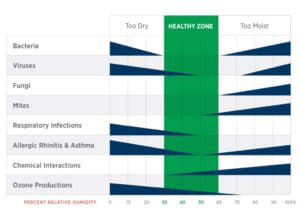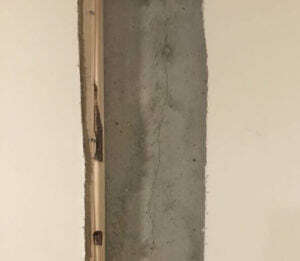
Originally published 1/18/2019; updated 5/3/2021
In the Midwest, we endure some pretty extreme weather variations. Summers are filled with high humidity, severe thunderstorms, and temperatures in the 90s. Winters bring snow, painfully dry air, and frigid temperatures that can drop into the negative. It’s a challenge to build a house that will endure such a diverse environment; it needs to be stable and strong, but with features that adapt as the circumstances change.
Over time, our environment corrodes and damages our homes. Foundations crack, water erodes the soil around them, drafts develop… And one day you notice that your utility bills may be going up, but your comfort level is going down.
Acculevel is a family-owned and operated company that repairs home foundations and waterproofs basements and crawl spaces. Since our start in 1996, we’ve helped more than 30,000 homeowners restore their homes to optimum health and stability. We provide whole-home solutions that address our customers’ needs and repair the issues that threaten the longevity of their homes.
In this article, we’re going to discuss three major ways you can improve your basement’s energy efficiency. We will also provide you with resources that further your knowledge of repair methods, costs, and symptoms that indicate you need a professional contractor’s help.
When you control the humidity level in your home, you are controlling the amount of moisture in the air. This improves your HVAC system’s efficiency, because dryer air is easier to cool, and flows more easily through the HVAC filter. It also immediately improves your air quality, because keeping a building at 50% humidity inhibits viruses, allergens, and bacteria.
 Information taken from a study performed by ASHRAE (the American Society of Heating, Refrigerating and Air-Conditioning Engineers.)
Information taken from a study performed by ASHRAE (the American Society of Heating, Refrigerating and Air-Conditioning Engineers.)
You might be wondering if a dehumidifier really will reduce your utility bills; after all, you’re adding a new appliance. But if your HVAC is cooling dryer air (not trying to both cool and dry it), the HVAC will run less frequently, while being more effective. A whole-home dehumidifier is also highly efficient, and has a low amp per water removal rating.
If you have noticeable drafts in your basement, the first thing you need to do is determine the source of the draft. Is it a gap between floor joists overhead? Is air seeping in where the concrete wall stops and the wooden flooring structure begins? Or is there a space between a door or window and its frame?
The source matters because some gaps are caused by slight, natural adjustments caused by the changing of the seasons. Gaps in areas like the floor joists or the sill plate are common results of seasonal damage. In those instances, spray foam insulation is an excellent option.
Spray foam insulation will get into even the smallest of spaces, is self-adhering, and repels moisture. This type of insulation prevents air and moisture from entering your basement, completely blocks any gaps or openings, and has a life expectancy of 80 years.
However, sometimes drafts are caused by your foundation settling unevenly. All homes settle- that’s what I meant when I described “slight natural adjustments.” But if one corner or side of your foundation settles at a faster rate than the others, this will cause structural problems with your home.
One of the most common indications of settling is problems with doors or windows. If your draft is coming from a door or window, try opening and closing it. Does it move easily on its track? Will it stay open or closed without a prop? If the answers are no, this may be a settling issue.
If this is the case, you should have your home evaluated by a professional foundation company. You need someone with knowledge and experience to assess your foundation for potential issues. In the video below, our Sales Director demonstrates how a rotating level is used for this purpose:
When you were searching for the source of the drafts, did you find any cracks in the walls? Thin, hairline cracks are relatively normal, and usually caused by changes in temperature, moisture, and the natural expansion and shrinkage of porous materials. (Remember concrete and wood are both porous, and will shift minutely with the seasons.)
All cracks should be repaired, because like too many problems in life, they only get worse over time. But if the crack is very thin, and isn’t admitting water or drafts, it’s not an urgent problem.
However, if water is seeping through the crack, or the crack is a draft source, it’s something you should attend to quickly.
 This photo was taken by an Acculevel project manager during a free estimate appointment. You can see a long hairline crack in the wall; this was found when it started leaking water and the drywall was damaged.
This photo was taken by an Acculevel project manager during a free estimate appointment. You can see a long hairline crack in the wall; this was found when it started leaking water and the drywall was damaged.
When cracks start expanding and admitting water, it’s time to take action. Most of these cracks are caused by hydrostatic pressure, which is the force applied to your foundation when there is a lot of rainwater in the soil. Once the ground is fully saturated, excess water tries to keep expanding- even when your house gets in the way. This puts pressure on the foundation, gradually creating small fissures in the walls.
Many times, installing an interior waterproofing system is enough to resolve the issue. This works because it relieves the pressure on the wall, gives the water a clear path, and directs it to an exit via sump pump. The crack itself still needs to be repaired, of course, but water drainage should prevent hydrostatic pressure from creating additional cracks.
If the crack in your foundation wall is horizontal or a zig-zag pattern, you need more than waterproofing. If that wall is starting to lean or bow, you need more than waterproofing right now.
 This photo was taken by an Acculevel project manager during a free estimate appointment. This basement wall has both a horizontal and a stair-step crack; either one should be a ‘red flag’ for a homeowner.
This photo was taken by an Acculevel project manager during a free estimate appointment. This basement wall has both a horizontal and a stair-step crack; either one should be a ‘red flag’ for a homeowner.
Either type of crack is an indication that the wall is being pushed too far, and its stability is now in doubt. Walls that are leaning or bowing are an immediate concern, and should be evaluated by a professional as soon as possible.
While you are checking out your basement, I hope you’ll take a few minutes to review the exterior of your foundation and your property. We have developed a free DIY Home Inspection checklist that we’d like every homeowner to perform twice a year. This checklist walks you through a thorough examination of your home, while highlighting what you are looking for and why.
If you’ve found potential issues or concerns, and would like more information, please use our interactive system checker. This diagnostic tool helps you explore the possible signs and symptoms of foundation problems, while providing additional articles that explore causes, solutions, and repair costs.
You should look for an experienced local contractor and make an appointment. Before you sign a contract for any service, you should always verify the company is reputable, insured, and accredited by the Better Business Bureau.
If you aren’t comfortable with hiring a contractor, or if this is your first time working with one, check out our Questions to Ask a Contractor article. This blog explains what questions you should be asking, what answers to look for (and avoid!), and even provides a free downloadable version you can use during the contractor’s visit.
If you live in Indiana or the surrounding states, please call Acculevel and request a free estimate. One of our experienced project managers will evaluate your foundation’s condition, then recommend the best course of action for you, to keep your home strong and healthy for years to come.
[DISPLAY_ULTIMATE_SOCIAL_ICONS]